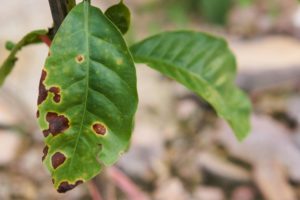Since its first known discovery in Kenya in the mid-nineteenth century, coffee rust has been spreading around the world. Traveling throughout the rest of Africa and Asia, and finally heading west to South America, Hemileia vastatrix wiped out or severely impacted all the major coffee-growing areas around the world except for one: Hawaii.
Coffee rust spreads easily by wind, splashing water, farm tools and human transport. Nearly 2,000 miles away from the nearest land mass, Hawai’i’s isolation kept the pathogen away until October 2020.

Given the devastating nature of the disease and the likely impact on Hawaii’s $54.3 million coffee crop—its second-largest agricultural commodity—growers and extension turned to the IR-4 Project for help.
In other parts of the world, coffee rust is managed with a combination of cultural practices, resistant varieties and systemic fungicides. However, there are no systemic fungicides registered for coffee rust in Hawaii, no resistant varieties and no time to perform efficacy research that is normally part of the registration process. The pathogen was already spreading on the islands of Hawaii, Maui and Lanai, causing its characteristic leaf spotting and severe defoliation.
Cooperation Between EPA, the Registrant and IR-4 Allows Quick Action
NC State University-based IR-4 Project Biologist Kathryn Homa specializes in plant pathology and reached out to several product registrants requesting their assistance in identifying fungicides that are effective on coffee rust and have international residue data and efficacy/crop safety data to support the use. This data would help with meeting the criteria for an emergency Section 18 exemption from the U.S. Environmental Protection Agency (EPA). Section 18 of the Federal Insecticide, Fungicide and Rodenticide Act (FIFRA) allows the EPA to temporarily permit an un-registered use of a pesticide to a federal or state agency when it is determined an emergency condition exists.
Coffee growers and the IR-4 Project believe the emergency situation clearly exists in Hawaii, but the second part of Section 18 criteria requires the product to meet the FIFRA safety standard of no unreasonable risk to human health and the environment. Proving this quickly means using data that already exists, plus a significant time investment on the part of the registrant to provide the necessary information.
IR-4 determined that the Section 18 criteria could likely be met with BASF’s systemic fungicide, Priaxor®, which is registered in the U.S. for use on other crops. Extensive international residue and efficacy data in coffee existed with the active ingredients of this product, fluxapyroxad and pyraclostrobin. Both of these compounds also have established import tolerances in the U.S. This data will shave years off the future Section 3 registration process domestically. BASF was also willing and committed to support the Section 18 request.
“The cooperation between BASF, IR-4 and EPA was essential in making this project move very quickly toward a solution,” Homa said. “This is not unusual, as IR-4 has a successful relationship with many registrants, and we have a history of cooperation between IR-4, registrants and EPA. This is one great example.”
“IR-4’s proposal to use BASF’s international residue data to support the use of fluxapyroxad and pyraclostrobin on coffee in the U.S. could be helpful in several ways,” said Ken Labbe, press officer for EPA. “First, it allows EPA chemists to determine, in advance of receiving a Section 18 application, that the international residue data do support the proposed use pattern. This could expedite the dietary risk assessment of a Section 18 application by accurately identifying the anticipated residues from this use.”
The Section 18 emergency exemption requested time-limited tolerances of 0.3 ppm for pyraclostrobin and 0.2 ppm for fluxapyroxad in coffee, green bean and a use for coffee on the Priaxor® Xemium® Brand Fungicide label to control coffee leaf rust.
Path is Paved for Faster Approval of Section 3 Registration
Labbe says EPA’s approval of IR-4’s ChemSAC proposal to use international data will also allow IR-4 to submit petitions for permanent U.S. tolerances for the proposed Section 3 registration of the use more quickly because no additional U.S. field residue trials will be needed.
According to Julie Coughlin, IR-4 field research director in Hawaii, IR-4 is conducting field trials in Hawaii and Puerto Rico in 2021 to determine the efficacy and crop safety of six additional fungicide products to control coffee leaf rust. She expects trial results by mid-2022. This will aid in the registration of additional fungicide products with different FRAC groups and help prevent resistance development to Priaxor®.
“Having a fungicide available that will provide long-lasting disease protection will be key to slowing the progression of this disease,” said Coughlin. “Growers currently have copper fungicides and a few biological products available for use, but these products only work as preventative or contact protectants and are not effective when coffee leaf rust infection levels exceed 5%. The Priaxor® Xemium® Brand Fungicide containing fluxapyroxad and pyraclostrobin delivers long-term control through locally systemic movement in the leaf tissue where the product is protected from rapid degradation.”
